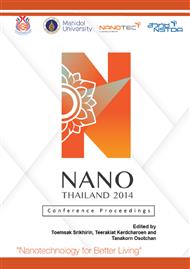[1]
F. Faizi, M. Noorani, M. Mahdavinejad, Propose a kind of optimal intelligent window in tropical region with an ability to reduce the input light and heat and having enough visibility to outside, International Conference on Intelligent Building and Management, Proc of CSIT. 5 (2011).
Google Scholar
[2]
M. Kamalisarvestani, R. Saidur, S. Mekhilef, F.S. Javadi, Performance, Materials and coating technologies of thermochromic thin films on smart windows, Renewable and Sustainable Energy Reviews. 26 (2013) 353–364.
DOI: 10.1016/j.rser.2013.05.038
Google Scholar
[3]
Information on http: /www. eppo. go. th/encon/ee20yrs/EEDP _Eng. pdf.
Google Scholar
[4]
S.Y. Li, G.A. Niklasson, C.G. Granqvist, Thermochromic fenestration with VO2-based materials: Three challenges and how they can be met, Thin Solid Films. 520 (2012) 3823–3828.
DOI: 10.1016/j.tsf.2011.10.053
Google Scholar
[5]
R. Arutjunjan, T. Markova, I. Halopenen, I. Maksimov, A. Yanush, Thermochromic Glazing for Zero Net Energy House, Proc. Glass Processing Days. 8 (2003) 299-301.
DOI: 10.1117/12.639322
Google Scholar
[6]
W. Callister, D. Rethwisch Smart materials, Fundamentals of Materials Science and Engineering, John Wiley & Sons. 3 (2008) 12.
Google Scholar
[7]
D. Talbot, Smart materials, the Institute of Materials, Minerals and Mining Schools Affiliate Scheme. (2003).
Google Scholar
[8]
P. Kiria, G. Hyettb, R. Binionsa, Solid state thermochromic materials, Advance Materials Letter 1. 2 (2010) 86-105.
Google Scholar
[9]
Y. Gao, H. Luo, Z. Zhang, L. Kang, Z. Chen, J. Du, M. Kanehira, C. Cao, Nanoceramic VO2 thermochromic smart glass: A review on progress in solution processing, Nano Energy. 1 (2012) 221–246.
DOI: 10.1016/j.nanoen.2011.12.002
Google Scholar
[10]
L. Zhao, L. Miao, S. Tanemura, J. Zhou, L. Chen, X. Xiao, G. Xu, A low cost preparation of VO2 thin films with improved thermochromic properties from a solution-based process, Thin Solid Films. 543 (2013) 157–161.
DOI: 10.1016/j.tsf.2012.11.154
Google Scholar
[11]
X. Chena, Q. Lva, X. Yi, Smart window coating based on nanostructured VO2 thin film, Optik. 123 (2012) 1187– 1189.
DOI: 10.1016/j.ijleo.2011.07.048
Google Scholar
[12]
C. Batista, R.M. Ribeiro, V. Teixeira, Synthesis and characterization of VO2-based thermochromic thin films for energy-efficient windows, Nanoscale Research Letters. (2011).
DOI: 10.1186/1556-276x-6-301
Google Scholar
[13]
P. Shukla, Y. Lin, E.M. Minogue, A.K. Burrell, T.M. McCleskey, Q. Jiaand, P. Lu, Polymer Assisted Deposition (PAD) of thin metal films: A new technique to the preparation of metal oxides and reduced metal films, Mater. Res. Soc. Symp. Proc. 893 (2006).
DOI: 10.1557/proc-0893-jj05-13
Google Scholar
[14]
A.K. Burrell, T.M. McCleskey, Q.X. Jia, Polymer assisted deposition, Chem. Commun. (2007) 1271–1277.
DOI: 10.1039/b712910f
Google Scholar
[15]
S. U. Hong, J.H. Jin, J. Won, Y.S. Kang, Polymer–Salt Complexes Containing Silver Ions and Their Application to Facilitated Olefin Transport Membranes, Adv. Mater. 12 (2000) 968-971.
DOI: 10.1002/1521-4095(200006)12:13<968::aid-adma968>3.0.co;2-w
Google Scholar
[16]
J. H. Kima, C. K. Kimb, J. Wonc, Y. S. Kanga, Role of anions for the reduction behavior of silver ions in polymer/silver salt complex membranes, Journal of Membrane Science. 250 (2005) 207–214.
DOI: 10.1016/j.memsci.2004.10.032
Google Scholar
[17]
S. Roy, Nanostructured PZT Synthesized from Metal–Polyvinyl Alcohol Gel: Studies on Metal–Polymer Interaction, Journal of Applied Polymer Science. V110 (2008) 2693–2697.
DOI: 10.1002/app.28332
Google Scholar
[18]
L. Kang,Y. Gao, H. Luo, A Novel Solution Process for the Synthesis of VO2 Thin Films with Excellent Thermochromic Properties, Applied material and surface. 1 (2009) 2211–2218.
DOI: 10.1021/am900375k
Google Scholar
[19]
Peter Woolf, Design of Experiments: Taguchi Methods, University of Michigan Michigan Chemical Process Dynamics and Controls.
Google Scholar
[20]
R. Lopeza, L. A. Boatner, T. E. Haynes, synthesis and characterization of size-controlled vanadium dioxide nanocrystals in a fused silica matrix, Journal of Applied Physics. 92 (2002) 4031-4036.
DOI: 10.1063/1.1503391
Google Scholar
[21]
S. R, Popuri, M. Miclau, A. Artemenko, C. Labrugere, A. Villesuzanne, M. Pollet, Rapid Hydrothermal Synthesis of VO2 (B) and Its Conversion to Thermochromic VO2 (M1), Inorg. Chem. 52 (2013) 4780−4785.
DOI: 10.1021/ic301201k
Google Scholar
[22]
Y. Zhang, X. Zhang, Y. Huang, C. Huang, F. Niu, C. Meng, X. Tan, One-step hydrothermal conversion of VO2(B) into W-doped VO2(M) and its phase transition and optical switching properties, Solid State Communications. 180 (2014) 24–27.
DOI: 10.1016/j.ssc.2013.10.028
Google Scholar
[23]
J.C. Valmalette, J.R. Gavarri, High efficiency thermochromic VO2(R) resulting from the irreversible transformation of VO2(B), Materials Science and Engineering. B54 (1998) 168–173.
DOI: 10.1016/s0921-5107(98)00148-2
Google Scholar


